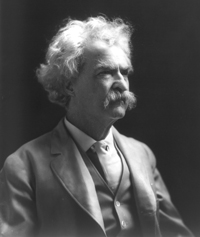As with hyperbole, understatement also occurs in poetry and other genres.
Remember that understatement deliberately downplays a situation’s importance and that writers often use it to achieve an ironic or humorous effect. Consider these examples:

Source: MarkTwain.LOC, Wikimedia

Source: William Shakespeare Chandos Portrait, Wikimedia
Mark Twain: “The report of my death was an exaggeration.”
Mercutio in Shakespeare’s Romeo and Juliet (speaking of the stab wound that will kill him): “’tis not so deep as a well, nor so wide as a church-door, but ’tis enough, ’twill serve . . .” (Act III,
scene i)
Robert Frost’s poem “Fire and Ice” is often cited as an example of understatement. Before you read the poem, think about the meaning of the last word of the poem, “suffice.” To suffice is “to adequately meet or satisfy a need.“ For example, you might say, “A brief note will suffice” or “These rations will suffice until next week.” Now read the poem and look for at least one example of understatement.

Source: Bob, misterbisson, Flickr
Fire and Ice
Some say the world will end in fire,
Some say in ice.
From what I’ve tasted of desire
I hold with those who favor fire.
But if I had to perish twice,
I think I know enough of hate
To say that for destruction ice
Is also great
And would suffice.
 “Fire and Ice” was published in 1920 shortly after the conclusion of World War I. Using your notes, answer these questions about the poem. When you are finished, check your understanding to see some possible responses.
“Fire and Ice” was published in 1920 shortly after the conclusion of World War I. Using your notes, answer these questions about the poem. When you are finished, check your understanding to see some possible responses. - What are the two forces that Frost identifies as ways in which the world might end?
- Given that the poem was published after the “war to end all wars,” many critics believe that Frost was comparing natural forces (fire, ice) to common human feelings such as passion/love/desire (symbolized by fire) and hate (symbolized by ice). Frost is emphasizing what quality of both fire and ice in this poem?
- How does Frost understate that quality in the last line?
Check Your UnderstandingSample Responses:
- Fire and ice
- Destructiveness
- Frost calmly states that either force—fiery passion or cold hate—will be adequate to bring about the destruction of the world. Using such a routine, unemotional word as “suffice” to talk about total devastation is an understatement.
As you apply what you have learned in this lesson to your reading, remember that hyperbole and understatement help communicate messages imaginatively. You won’t need to look far for hyperbole (for example, “Everything’s bigger in Texas”). You probably won’t have trouble finding understatement in certain kinds of writing either (for example, “Robert Frost knew a thing or two about writing poetry”). Hyperbole and understatement provide emphasis, and they add meaning and interest to texts.